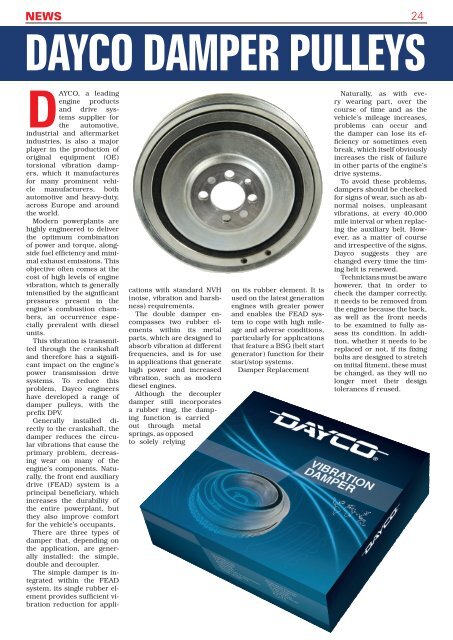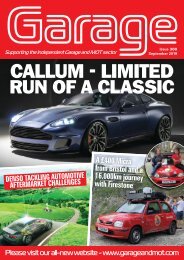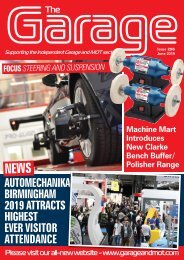You also want an ePaper? Increase the reach of your titles
YUMPU automatically turns print PDFs into web optimized ePapers that Google loves.
news 24<br />
DAYCO DAMPER PULLEYS<br />
Dayco, a leading<br />
engine products<br />
and drive systems<br />
supplier for<br />
the automotive,<br />
industrial and aftermarket<br />
industries, is also a major<br />
player in the production of<br />
original equipment (OE)<br />
torsional vibration dampers,<br />
which it manufactures<br />
for many prominent vehicle<br />
manufacturers, both<br />
automotive and heavy-duty,<br />
across Europe and around<br />
the world.<br />
Modern powerplants are<br />
highly engineered to deliver<br />
the optimum combination<br />
of power and torque, alongside<br />
fuel efficiency and minimal<br />
exhaust emissions. This<br />
objective often comes at the<br />
cost of high levels of engine<br />
vibration, which is generally<br />
intensified by the significant<br />
pressures present in the<br />
engine’s combustion chambers,<br />
an occurrence especially<br />
prevalent with diesel<br />
units.<br />
This vibration is transmitted<br />
through the crankshaft<br />
and therefore has a significant<br />
impact on the engine’s<br />
power transmission drive<br />
systems. To reduce this<br />
problem, Dayco engineers<br />
have developed a range of<br />
damper pulleys, with the<br />
prefix DPV.<br />
Generally installed directly<br />
to the crankshaft, the<br />
damper reduces the circular<br />
vibrations that cause the<br />
primary problem, decreasing<br />
wear on many of the<br />
engine’s components. Naturally,<br />
the front end auxiliary<br />
drive (FEAD) system is a<br />
principal beneficiary, which<br />
increases the durability of<br />
the entire powerplant, but<br />
they also improve comfort<br />
for the vehicle’s occupants.<br />
<strong>The</strong>re are three types of<br />
damper that, depending on<br />
the application, are generally<br />
installed: the simple,<br />
double and decoupler.<br />
<strong>The</strong> simple damper is integrated<br />
within the FEAD<br />
system, its single rubber element<br />
provides sufficient vibration<br />
reduction for applications<br />
with standard NVH<br />
(noise, vibration and harshness)<br />
requirements.<br />
<strong>The</strong> double damper encompasses<br />
two rubber elements<br />
within its metal<br />
parts, which are designed to<br />
absorb vibration at different<br />
frequencies, and is for use<br />
in applications that generate<br />
high power and increased<br />
vibration, such as modern<br />
diesel engines.<br />
Although the decoupler<br />
damper still incorporates<br />
a rubber ring, the damping<br />
function is carried<br />
out through metal<br />
springs, as opposed<br />
to solely relying<br />
on its rubber element. It is<br />
used on the latest generation<br />
engines with greater power<br />
and enables the FEAD system<br />
to cope with high mileage<br />
and adverse conditions,<br />
particularly for applications<br />
that feature a BSG (belt start<br />
generator) function for their<br />
start/stop systems.<br />
Damper Replacement<br />
Naturally, as with every<br />
wearing part, over the<br />
course of time and as the<br />
vehicle’s mileage increases,<br />
problems can occur and<br />
the damper can lose its efficiency<br />
or sometimes even<br />
break, which itself obviously<br />
increases the risk of failure<br />
in other parts of the engine’s<br />
drive systems.<br />
To avoid these problems,<br />
dampers should be checked<br />
for signs of wear, such as abnormal<br />
noises, unpleasant<br />
vibrations, at every 40,000<br />
mile interval or when replacing<br />
the auxiliary belt. However,<br />
as a matter of course<br />
and irrespective of the signs,<br />
Dayco suggests they are<br />
changed every time the timing<br />
belt is renewed.<br />
Technicians must be aware<br />
however, that in order to<br />
check the damper correctly,<br />
it needs to be removed from<br />
the engine because the back,<br />
as well as the front needs<br />
to be examined to fully assess<br />
its condition. In addition,<br />
whether it needs to be<br />
replaced or not, if its fixing<br />
bolts are designed to stretch<br />
on initial fitment, these must<br />
be changed, as they will no<br />
longer meet their design<br />
tolerances if reused.<br />
24 News.indd 1 27/08/2019 10:20
















